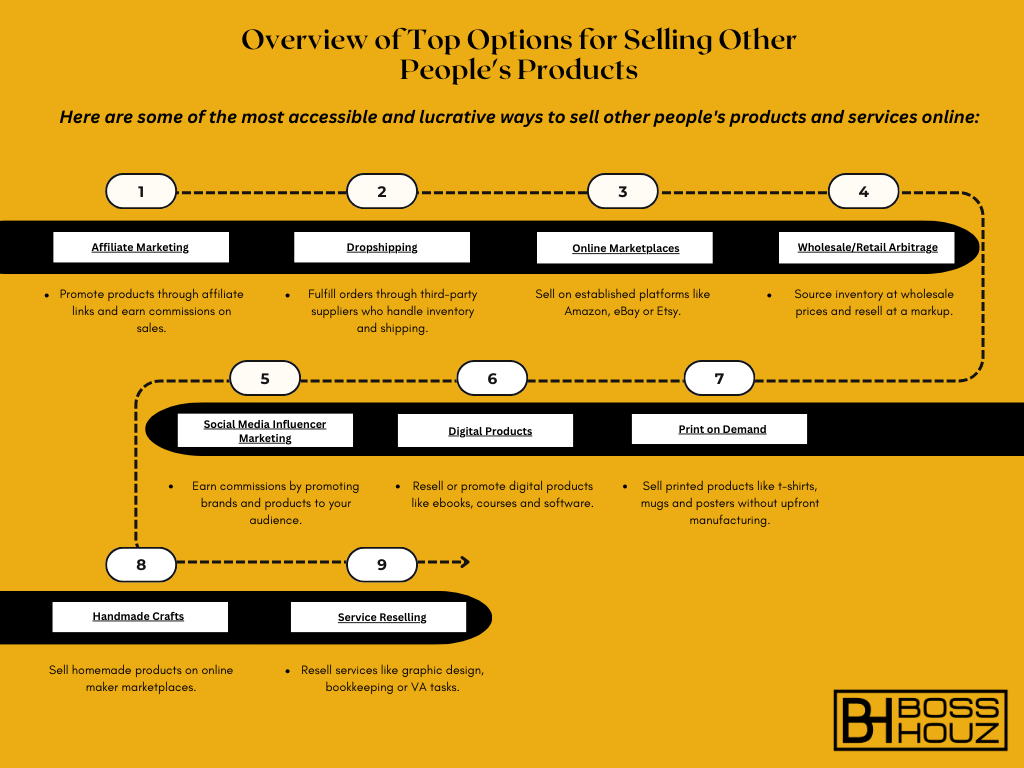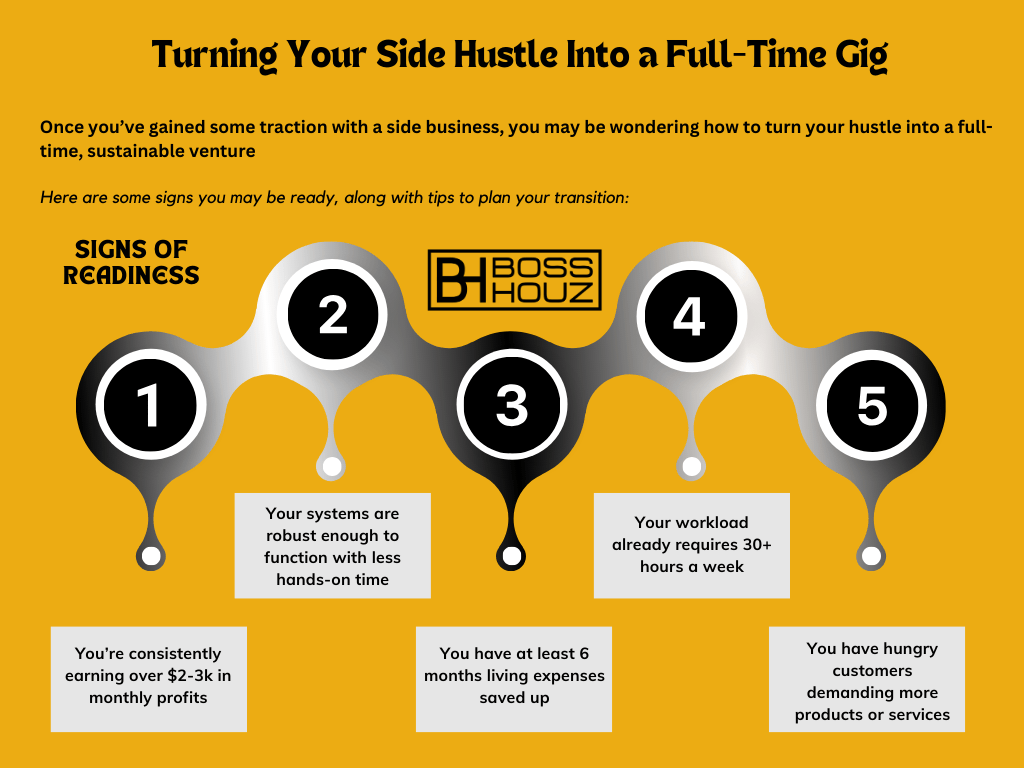Are you an aspiring entrepreneur looking to start an online business? Want to earn money working from home? Selling other people’s products could be a great way to get started!
Unlike traditional brick-and-mortar businesses that require significant startup capital, physical storefronts, and inventory, selling online leverages the power and reach of the internet to connect you with customers globally. You don’t need to manufacture your own products or carry any stock. By finding ways to promote other companies’ offerings in exchange for commissions or revenue share, you can launch your own digital storefront with minimal investment.
In this comprehensive guide, we’ll explore some of the most popular and proven methods for making money online by selling other peoples products. Whether you want to earn some supplementary income on the side or eventually turn your e-commerce venture into a full-time business, these strategies can help you get started.
Table of Contents
Overview of Top Options for Selling Other People’s Products

Here are some of the most accessible and lucrative ways to sell other people’s products and services online:
- Affiliate Marketing: Promote products through affiliate links and earn commissions on sales.
- Dropshipping: Fulfill orders through third-party suppliers who handle inventory and shipping.
- Online Marketplaces: Sell on established platforms like Amazon, eBay or Etsy.
- Wholesale/Retail Arbitrage: Source inventory at wholesale prices and resell at a markup.
- Social Media Influencer Marketing: Earn commissions by promoting brands and products to your audience.
- Digital Products: Resell or promote digital products like ebooks, courses and software.
- Print on Demand: Sell printed products like t-shirts, mugs and posters without upfront manufacturing.
- Handmade Crafts: Sell homemade products on online maker marketplaces.
- Service Reselling: Resell services like graphic design, bookkeeping or VA tasks.
Let’s explore each of these options in more detail:
Selling Other People’s Products Online: Models and Strategies
Affiliate Marketing
Affiliate marketing is one of the most popular ways to generate income through other people’s products. As an affiliate, you earn commissions by promoting products from other companies.
Here’s a quick rundown of how affiliate marketing works:
- You join an affiliate program for a company whose products you want to promote. Most major retailers like Amazon, Walmart, Target, etc. have affiliate programs.
- You receive a unique affiliate link or tracking ID.
- You promote the company’s products through your website, email list, social media channels, YouTube videos, etc.
- When someone makes a purchase using your affiliate link, you earn a commission. Commissions average 4-10% but can reach up to 75% for digital products.
Benefits
- Extremely low barrier to entry. You don’t need any inventory or shipping capabilities.
- Vast selection of products to promote from leading retailers and brands.
- Recurring passive income potential as customers make repeat purchases.
- Flexible model that can be scaled up over time at your own pace.
Challenges
- Requires consistently driving targeted traffic to your affiliate links.
- Tracking sales and monitoring affiliate networks can be tedious.
- Lower commissions compared to selling your own physical or digital products.
Tips for Success
- Find a niche and become a subject matter expert. Promote products highly relevant to your audience.
- Create detailed reviews, comparison articles, tutorials, and other content that adds value for readers while organically incorporating affiliate links.
- Build trust and authority. The best affiliates have an engaged community of loyal followers.
- Diversify traffic sources. Leverage social media, SEO, email marketing, and paid ads.
- Track analytics to identify your most profitable traffic sources and promotion tactics.
Dropshipping
Dropshipping allows you to sell products directly to customers without handling any inventory. When you get an order, you forward it to your supplier and they ship the product on your behalf.
Here is an overview of how dropshipping supply chains work:
- You set up an online store and list products from dropshipping suppliers. Many suppliers provide product info and images.
- When you get an order, you forward it to the supplier with your customer’s shipping details.
- The supplier packages and ships the product directly to your customer.
- You keep the profit margin between the wholesale supplier price and the retail customer price.
Benefits
- Super low startup costs. You can launch a store with minimal investment.
- No inventory overhead. You don’t have to purchase or store any products.
- Flexibility to switch suppliers and products based on profitability.
- Scalable model that can be grown exponentially once you find winning products.
Challenges
- Low margins on extremely competitive products can be unprofitable.
- Managing multiple suppliers and logistics can be complex as you grow.
- Potential shipping delays can impact customer satisfaction.
- Limited control over product quality.
Tips for Success
- Use Oberlo or another dropshipping automation tool to streamline order processing.
- Focus on winning products with higher margins and lower competition.
- Provide stellar customer service and communication to offset logistics issues.
- Closely monitor supplier reliability and order fulfillment times.
- Experiment extensively to find products that sell before scaling up.
Online Marketplaces
Online marketplaces like Amazon, eBay and Etsy provide instant access to millions of buyers. You can sell products directly through these sites without having to build your own ecommerce store.
Here are some benefits and considerations of selling on online marketplaces:
Benefits
- Instant access to massive built-in audience of buyers.
- Can start selling immediately without a website or marketing channels.
- Established platform handles payment processing, order management and customer service.
- Can sell as a side hustle or full-time business.
Challenges
- Lots of competition on popular marketplaces, so difficult to stand out.
- Must pay sales commissions and fees that cut into profits.
- Could run into product listing restrictions or get account suspended for violations.
- Harder to build unique brand identity and make direct customer connections.
Tips for Success
- Closely study marketplace rules and restrictions for sellers to avoid issues.
- Focus on highly targeted, less competitive niche categories relevant to your expertise.
- Provide stellar customer service and communicate extensively with buyers.
- Carefully craft listings with great photos, detailed descriptions and strategic keywords.
- Leverage Fulfilled by Amazon (FBA) or other fulfillment services to simplify logistics.
Wholesale and Distribution
Selling wholesale allows you to buy products in bulk quantity directly from manufacturers or distributors and resell to retailers or direct to consumers.
Here is an overview of typical wholesale workflows:
- Research and connect with manufacturers and distributors to establish accounts.
- Negotiate wholesale pricing based on large order quantities.
- Purchase inventory in bulk to get better unit costs.
- Sell products at a markup to retailers, small businesses, online stores or individual consumers.
- Handle storage, packaging and order fulfillment logistics.
Benefits
- Ability to purchase products at deeply discounted wholesale rates.
- Higher profit margins by controlling inventory costs.
- Establish wide distribution through networks of resellers and retailers.
- Own and control branding and merchandising.
Challenges
- Requires significant upfront capital to purchase inventory.
- Storage, inventory management and fulfillment can be complex and costly.
- It takes time and effort to build distribution networks and partnerships.
Tips for Success
- Start small and focus on a narrow niche so you can closely manage initial inventory.
- Develop win-win partnerships with a small number of retailers/resellers to establish distribution.
- Streamline fulfillment with automated inventory management and order processing.
- Keep close tabs on cash flow and product turnover to maintain optimal inventory levels.
Social Media Influencer Marketing
If you have a large social media following and strong engagement, you may be able to monetize your audience by promoting other companies’ products.
Here are some ways social influencers can earn money:
- Direct sales commissions when followers purchase products you endorse.
- Free products or services in exchange for organic promotions and reviews.
- Advertising revenue from branded content, takeovers, and other sponsorships.
- Affiliate sales through links and promo codes for follower purchases.
- Ambassador or sponsorship deals and collaborations with brands.
Benefits
- Leverage existing audience and platforms like Instagram or TikTok.
- Make money from content creation and influencer work you likely already do.
- Get free products and build partnerships with exciting brands.
- Creative fulfillment from producing videos and telling stories with products.
Challenges
- Requires very large following and high engagement for significant income.
- Relying solely on sponsorships can seem inauthentic to your audience.
- Negotiating profitable deals involves business experience many creators lack.
Tips for Success
- Find affiliate programs and collaborations that align naturally with your niche.
- Disclose paid endorsements ethically and keep majority of content non-promotional.
- Negotiate rates based on follower count, engagement metrics, and audience demographics.
- Develop long-term, ongoing partnerships through multi-post campaigns and brand ambassador deals.
Digital Products
Selling digital products like ebooks, online courses, templates, and more is a booming market. You can find bestselling digital products to promote as an affiliate, or even create your own.
Popular types of digital products include:
- Online courses and coaching programs
- Ebooks, guides and workbooks (PDFs)
- Stock photos, graphics, templates, and design assets
- Website themes, plugins, and scripts
- Mobile apps and SaaS platforms
- Audio samples, podcasts, and music
- Subscriptions for access to tools or exclusive content
Benefits
- Extremely high margins since there is no per-unit production or distribution cost.
- Scalable passive income with potential for residual sales through affiliates.
- Establish yourself as an expert by creating high-value content and tools.
- Build recurring revenue through memberships and digital subscriptions.
Challenges
- Requires expertise and intensive effort to create quality digital products.
- Marketing and selling digital products in a crowded space dominated by tech giants.
- Preventing piracy of unprotected digital files and assets.
Tips for Success
- Survey your audience to validate demand and willingness to pay for a particular digital product concept.
- Partner with other creators or outsource parts of production to speed up content creation.
- Use AI copywriting tools to generate drafts, outlines, and content frameworks.
- Gate some content in your free offering to demonstrate value and drive sales of the full product.
- Implement digital rights management and strategic bundling/pricing tactics to maximize profitability.

Print on Demand (POD)
Print on demand lets you sell printed products like books, merchandise, or wall art without any upfront manufacturing costs or inventory.
When customers order your products, print on demand companies like Printful and Redbubble produce a unit and ship it directly to them. Common POD products include:
- T-shirts, hoodies, hats, and apparel
- Mugs, water bottles, and other drinkware
- Wall posters and canvas artwork
- Phone cases and tech accessories
- Specialty books, calendars, and stationery
Benefits
- Zero upfront costs for production. Inventory, manufacturing, and shipping all handled by the POD supplier.
- Easily launch new product lines and experiment with minimal financial risk.
- Fully branded products that look like your own merchandise line.
- Integrations with Shopify, WooCommerce, and other ecommerce platforms for seamless order fulfillment.
Challenges
- Lower profit margins on POD products compared to manufacturing at scale.
- Limited control over production quality and shipping timelines.
- Requires significant marketing investment to compete and drive sales.
Tips for Success
- Use POD to validate product demand before investing in large inventory orders.
- Focus branding and designs on niche interests and pop culture trends.
- Build an audience and community around your brand through content marketing.
- Leverage targeted paid ads to find buyers aligned with your products.
Handmade Products
Sites like Etsy, ArtFire, and HandmadeAmazon let you easily sell handmade crafts, art, jewelry, home goods, and more in online maker marketplaces.
Some tips for successfully selling DIY and handcrafted goods:
Benefits
- Low startup costs if you already craft as a hobby.
- Creative fulfillment from turning your art and crafts into an income source.
- Expand an existing Etsy shop into a full-time business.
Challenges
- Requires extensive investment of time to create quality handmade inventory.
- Maximizing efficiency and profitability can be difficult when scaling up.
- Competing with lower priced manufactured goods.
Tips for Success
- Carefully craft listings with great photos/descriptions to command premium pricing.
- Offer custom and personalized options to increase order value.
- Create shop policies that set buyer expectations around production timelines and shipping.
- Streamline operations with organization systems, production processes, and automation tools.
- Use social media and content marketing to share your brand story and production journey.
Service Arbitrage
Selling services instead of physical products is another way to build a business through other skilled professionals. Service arbitrage involves reselling skills that you don’t necessarily deliver yourself.
For example, you could build a marketing agency that resells services like:
- Graphic design
- Web development
- Bookkeeping
- Business consulting
- Writing and translation
- Virtual assistance
Benefits
- Flexible work selling skills in domains you enjoy but aren’t an expert in yourself.
- Recurring revenue through ongoing service contracts vs one-time sales.
- Agencies command premium rates compared to freelancers.
Challenges
- Managing teams of freelancers or service partners.
- Consistently delivering quality service at scale.
- Securing top talent across different service offerings.
Tips for Success
- Start very specialized. Focus on becoming the best provider of a narrow niche service.
- Rigorously vet freelancers and build systems to ensure service quality.
- Prioritize client outcomes over maximizing hours billed. High-touch support builds loyalty.
- Develop packaged solutions that streamline and scale core service offerings.
- Automate administrative tasks and centralize project management to support growth.
How to Choose the Best Business Model for You
With so many options, how do you determine the best ways to make money selling other people’s products and services? Here are some key factors to consider:
Startup Costs and Effort Required
Some models like affiliate marketing and online marketplaces have extremely low startup costs. You can get up and running in days by signing up for affiliate networks or marketplace seller accounts. Others like wholesale and manufacturing require more significant upfront investments in inventory, storage, packaging, etc.
Some models are also far more logistically complex, involving supply chain coordination, fulfillment, and physical products. Make sure you take operations and your own bandwidth into account.
Skills and Experience
Evaluate which business models align with your natural strengths and interests. Play to your existing skills instead of starting from scratch. For example, if you love social media and content creation, focus on influencer marketing. If you’re a skilled artisan, try handmade products. For technical skills, explore digital products or service arbitrage.
Profit Margin and Earnings Potential
While some models provide faster revenue, profit margins can make a big difference in your actual take-home income. Weigh startup costs against longer term earning potential for a more complete financial picture.
Scalability and Growth Trajectory
If your goal is generating some supplementary income, any model can potentially work. But certain options offer clearer paths to scaling your earnings and growing a larger business over time. For bigger aspirations, look for highly scalable models like affiliate marketing, dropshipping or digital products.
Passion and Motivation
Above all else, choose a business model that genuinely excites and motivates you. Your natural passion will translate into the effort and ingenuity required to overcome challenges and stand out from the competition. Selling something you truly connect with makes success far more likely.
By carefully weighing these key factors against your own personal goals, you can determine the best path forward. Don’t be afraid to start small and experiment until you find an approach that clicks. Agile entrepreneurs adapt and evolve their business models over time.
How to Setup Your Business for Success
Once you’ve selected one or more preferred models to focus on, here’s how to transform your venture from idea to reality:
1. Nail Product-Market Fit
Rather than hopping on trends, take time up front to deeply understand your target audience and identify products that solve their needs or desires. Study customer reviews and survey potential buyers directly through social media polls or email outreach. Find specific gaps your offerings can fill instead of competing head to head with major brands.
2. Develop Specialized Knowledge
Become a subject matter expert in your niche products, industry, target demographics, etc. Follow trends, news, and influencers to stay on the pulse. Share your specialized knowledge through content that educates and builds trust with your audience.
3. Master Digital Marketing Basics
From search engine optimization to email automation to paid social advertising, digital marketing skills are foundational.
4. Build an Authoritative Brand
Don’t just be another anonymous seller. Invest in branding, copywriting, and content that expresses your unique story and value. Use social proof like testimonials and reviews to establish credibility.
5. Provide Impeccable Customer Service
Compete on superlative service and support, not just price or products. Reply quickly, fulfill orders accurately, and rectify any issues promptly. Go above and beyond to turn happy customers into brand advocates.
6. Continuously Test and Optimize
Treat your business like a living organism that constantly evolves through experiments. Try new products, tactics, and partnerships frequently. Use data to double down on what works and cut what doesn’t.
7. Automate Systems and Processes
Streamline operations through fulfillment integrations, email sequences, chatbots, and other tools that save you time on repetitive tasks. Focus your energy on high-impact priorities.
8. Reinvest Profits in Growth
Be patient and reinvest early earnings back into your venture for compounding returns. Hire help if needed to strengthen capabilities and capacity. Think long term by laying foundations today.
9. Diversify Income Streams
Don’t rely on a single product line, traffic source, or platform. Spread risk across multiple income streams including recurring revenue like memberships and services. Build flexibility to fluidly adapt.
10. Stay Agile and Future-Proof
Complacency kills. Continue evaluating emerging technologies, competitors, and market shifts. Keep iterating your business model to ride new opportunities faster than others.
By combining passion, grit, strategic business development, and the right online selling model, you can build a lucrative business that gives you the freedom and fulfillment you seek.
Turning Your Side Hustle Into a Full-Time Gig

Once you’ve gained some traction with a side business, you may be wondering how to turn your hustle into a full-time, sustainable venture.
Here are some signs you may be ready, along with tips to plan your transition:
Signs of Readiness
- You’re consistently earning over $2-3k in monthly profits
- Your systems are robust enough to function with less hands-on time
- You have at least 6 months living expenses saved up
- Your workload already requires 30+ hours a week
- You have hungry customers demanding more products or services
Preparing for the Leap
- Scale content and marketing to keep driving sales at higher volumes
- Strengthen automations and streamline systems to reduce day-to-day workload
- Line up contractors or team members to offload specialized work
- Forecast finances and get very clear on upcoming expenses and cash flow
- Give your current job sufficient notice and leave on good terms
- Bolster mental and physical health practices to manage stress and avoid burnout
Making it Work
- Institute consistent daily and weekly planning sessions to stay strategic
- Maintain work/life separation by setting boundaries and office hours
- Leverage tools like Trello or Asana to manage projects and stay on top of tasks
- Create a diverse support network for advice, accountability and sounding boards
- celebrate wins both big and small to keep motivation high through ups and downs
Listen to your intuition. If you have the financial safety net, proven business model, and excitement about your venture, take the leap. Keep costs low and cash flow healthy while aggressively growing the business the first year. Stay focused and be patient – your hard work will pay off.
FAQs: Making Money Online Selling Other People’s Products
Is selling other people’s products online actually profitable?
Yes, there are many very profitable ways to sell other people’s products or services online. Business models like dropshipping, affiliate marketing, Amazon FBA, and social media brand sponsorships have enabled people to earn thousands per month selling other brands’ products. It’s just important to choose the right niche, learn effective digital marketing strategies, and provide great customer service.
How much money can I realistically make as a beginner?
When just starting out, aim for $500-1000 in profit your first month, with steady growth to $2000-5000 monthly profit within 6 months. With consistent effort and reinvesting revenue into growth, you can then scale up to 5-6 figures monthly revenue within 1-2 years.
What selling platforms are best for beginners?
Beginner-friendly platforms include: Shopify for ecommerce, Amazon and eBay for marketplaces, affiliate programs from companies like Amazon, Clickbank or ShareASale, and social media platforms like Instagram and TikTok for influencer marketing.
Do I need to build my own website?
Your own website isn’t completely necessary to sell others’ products, especially when starting out. You can begin selling through existing marketplaces and affiliate programs first. Eventually, having your own branded site helps establish credibility and control over the customer experience.
What are the risks involved with selling online?
Common risks include unpredictable income swings, platform policy changes that impact sales, competitors stealing your product ideas, excessive advertising costs without ROI, and struggling to consistently acquire customers. Doing thorough market validation, diversifying income sources, and building emergency savings can help mitigate risk.
How much time per week does this business model require?
Expect to spend 20-30+ hours per week when first launching your business. After streamlining operations, most sellers spend 10-15 hours weekly maintaining their business, and then outsource or automate remaining tasks wherever possible.
What skills or experience do I need to get started?
You don’t need specific experience, but core skills like basic technology proficiency, organization, customer service, marketing/sales, time management, and financial analytics will help you succeed. Identify any skill gaps and invest in education.








